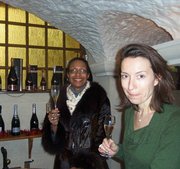Many of us celebrated the beginning of the New Year with that golden bubbling drink known as champagne. Have you ever wondered where does it come from? Why is it called champagne? How is it made? What makes it bubble? Just what is the story behind champagne?
(Courtesy Photo)
Baltimore native Gyl Golden (left) samples champagne in Hautvillers at the Gobillard Champagne House in France.
Since it’s creation by the monk Dom Perignon in the 17th century, no other wine has rivaled champagne as the symbol of luxury and perfection. According to French law, only wine from the region of Champagne, which is grown in designated areas, then aged and bottled according to the strictest standards called “methode champenoise” can be labeled as champagne. Most champagne is non-vintage— the skill of the blenders using reserves of older wine, creates consistency and excellence year after year. Sparkling wines made outside of Champagne cannot be labeled champagne.
The region of Champagne is a very compact district consisting of Reims and Epernay largely in the French department of the Marne. Three varieties of grapes are grown, Pinot Noir, Pinot Meunier and Chardonnay. Most champagne is a blend of all three, though Blanc de Blanc is 100 percent chardonnay and Blanc de Noir, although white is made only from red grapes. The grandes marques, or “big names” command the prestige and prices, but many small growers and cooperatives also produce excellent-value wine well worth seeking out.
To produce its characteristic bubbles, champagne has to undergo a process of double fermentation, the “methode champenoise.” In the first fermentation, the house wine made from rather acidic grapes is fermented at 68 -72F in either stainless steel tanks or traditional oak barrels. It is then siphoned off from the sediment and kept at colder temperatures to clear completely, before being drawn off and blended with wines from other areas and years. The wine is bottled and “liqueur de triage,” combination of sugar, wine and yeast is added.
During the second fermentation, the bottles are stored for a year or more in cool chalky cellars. The yeast converts the sugar to alcohol and carbon dioxide, which produce the sparkle, and the yeast cells die leaving a deposit. To remove this, the inverted bottles are turned and tapped daily during a process called “remuage” to shift the deposits into the neck of the bottle. Finally, the deposits are expelled by the process known as “degorgement” and a bit of sugar is added to adjust the sweetness before the final cork is inserted.
A well-known “grand marque” Moet & Chandon was started in 1743 and is the largest Champagne House. This group owns other Champagne Houses including: Mercier; Krug; Pommery; and Veuve Clicquot. Other producers include: Bollinger; Taittinger; and Ruinart.
If you ever have the opportunity to travel to Paris, France be sure to include a day trip to Reims for a champagne tour or a visit to Epernay for a walk along
Avenue de Champagne where the Champagne Houses are located for a tasting and tour. If you are unable to get to France anytime soon, visit one of our local wine shops in town such as The Wine Source, 3601 Elm Avenue; The Wine Market, 921 E. Fort Avenue; or Wine Underground, 4400 Evans Chapel Road.

